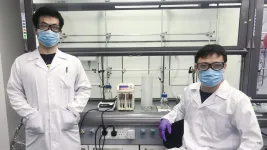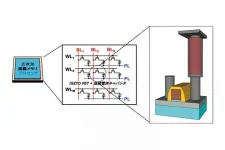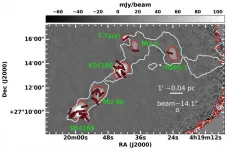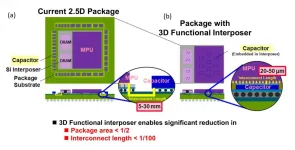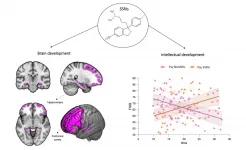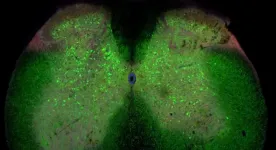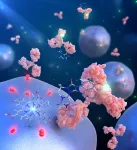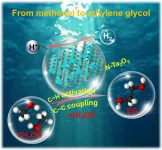(Press-News.org) Singapore, 1 June 2021 - The discovery and development of new small-molecule compounds for therapeutic use involves a huge investment of time, effort and resources. Giving a new spin to conventional chemical synthesis, a team of researchers from the National University of Singapore (NUS) has developed a way to automate the production of small molecules suitable for pharmaceutical use. The method can potentially be used for molecules that are typically produced via manual processes, thereby reducing the manpower required.
The research team that achieved this technological breakthrough was led by Assistant Professor Wu Jie from the NUS Department of Chemistry as well as Associate Professor Saif A. Khan from the NUS Department of Chemical and Biomolecular Engineering.
Demonstrating the novel technique on prexersatib, a pharmaceutical molecule used in cancer treatment, the NUS team achieved a fully automated six-step synthesis with 65 per cent isolated yield within 32 hours. In addition, their technique also successfully produced 23 prexasertib derivatives in an automated fashion, signifying the method's potential for drug discovery and design.
The findings, which were first published in the journal Nature Chemistry on 19 April 2021, can potentially be applied to the production of a wide-range of pharmaceutical molecules.
Simplifying the production of pharmaceutical compounds
Recent advances in end-to-end continuous-flow synthesis are rapidly expanding the capabilities of automated syntheses of small-molecule pharmaceutical compounds in flow reactors. There are well-defined production methods for molecules such as peptides and oligonucleotides which have repeating functional units. However, it is challenging to conduct multi-step continuous-flow synthesis of active pharmaceutical ingredients due to issues such as solvent and reagent incompatibilities.
The new automated technique developed by the NUS research team combines two chemical synthesis techniques. These comprise continuous-flow synthesis, where chemical reactions are carried out in a seamless process, and solid-supported synthesis, in which molecules are chemically bonded and grown onto an insoluble support material.
Their novel technique, called solid phase synthesis-flow, or SPS-flow, enables the target molecule to be developed on a solid supporting material as the reaction reagent flows through a packed-bed reactor. The entire process is controlled by computer automation. Compared to existing automated techniques, the SPS-flow method enables wider reaction patterns and longer linear end-to-end automated synthesis of pharmaceutical compounds.
The researchers tested their technique on cancer-inhibiting molecule prexasertib due to its suitability in being attached to solid resin which was used as the support material. Their experiments showed a yield of 65 per cent after 32 hours of continuous automated execution. This is an improvement from the existing method of producing prexasertib that is estimated to take around a week, and requires an extensive six-step manual process and purification procedure to produce a yield of up to 50 per cent.
The new method also allows for synthetic modifications early in the process, hence enabling greater structural diversification compared to traditional methods which only allow late-stage diversification of a molecule's common core structure. Using a computer-based chemical recipe file, the team successfully produced 23 derivative molecules of prexasertib. The derivatives produced are molecules with parts of the molecular structure differing slightly from the original molecule.
"The capability to easily obtain these derivatives is crucial during the drug discovery and design process as understanding the relationship between molecule structures and their activities play an important role for the selection of promising clinical candidates," explained Assoc Prof Khan.
Creating new possibilities in drug development
The NUS team plans to further showcase their SPS-flow technique's versatility by conducting more research incorporating top-selling pharmaceutical molecules.
"Our new technique presents a simple and compact platform for on-demand automated synthesis of a drug molecule and its derivatives. We estimate that 73 per cent of the top 200 bestselling small-molecule drugs could be produced using this technique," said Asst Prof Wu.
Future studies taken by the team will target the development of a fully automated and portable system for active pharmaceutical ingredient production at a larger scale suitable for manufacturing. The system will apply the newly developed technique in lead optimisation to speed up the process of drug discovery.
INFORMATION:
Bribery in the public healthcare does not solve the problem of poor quality of services, and even exacerbates it, researchers argue. The same can be said about the well-being of patients and their own assessment of health. In other words, bribes in the healthcare do not provide good quality services and do not pay off. Such conclusions were reached by an international team of researchers, including Olga Popova, the article's co-author, an associate professor at the Ural Federal University (UrFU, Russia).
Researchers examined survey data on 41,000 citizens from 28 post-communist countries in Central and Eastern Europe, as well as ...
Tokyo - Machine learning is the process by which computers adapt their responses without human intervention. This form of artificial intelligence (AI) is now common in everyday tools such as virtual assistants and is being developed for use in areas from medicine to agriculture. A challenge posed by the rapid expansion of machine learning is the high energy demand of the complex computing processes. Researchers from The University of Tokyo have reported the first integration of a mobility-enhanced field-effect transistor (FET) and a ferroelectric capacitor (FE-CAP) to bring the memory system into the proximity of a microprocessor and improve the ...
In the modern day, our interactions with voice-based devices and services continue to increase. In this light, researchers at Tokyo Institute of Technology and RIKEN, Japan, have performed a meta-synthesis to understand how we perceive and interact with the voice (and the body) of various machines. Their findings have generated insights into human preferences, and can be used by engineers and designers to develop future vocal technologies.
As humans, we primarily communicate vocally and aurally. We convey not just linguistic information, but also the complexities of our emotional states and personalities. Aspects of our voice such as tone, rhythm, and pitch are vital to the way we are perceived. In other words, the way we say things matters.
With advances in ...
Magnetic fields are ubiquitous throughout our Milky Way Galaxy and play a crucial role in all dynamics of interstellar medium. However, questions like how Solar-type stars form out of magnetized molecular clouds, whether the role of magnetic fields changes at various scales and densities of molecular clouds, and what factors can change the morphology of magnetic fields in low-mass dense cores still remain unclear.
A new study led by Dr. Eswaraiah Chakali from Prof. LI Di's research group at the National Astronomical Observatories of the Chinese Academy of Sciences (NAOC) has partially answered these questions. ...
Scientists at Tokyo Institute of Technology develop a 3D functional interposer--the interface between a chip and the package substrate--containing an embedded capacitor. This compact design saves a lot of package area and greatly reduces the wiring length between the chip's terminals and the capacitor, allowing for less noise and power consumption. Their approach paves the way to new semiconductor package structures with greater miniaturization.
Electronics started big size-wise but have only grown smaller and more compact over time. Today, even smartphones outperform the bulky computers from the 1980s by orders of magnitude. Unfortunately, ...
Up to three quarters of the biodiversity living on Western Australia's iconic ironstone mountains in the State's Mid West (known as Banded Iron Formations) could be difficult or impossible to return quickly to its previous state after the landscape has been mined, a Curtin University study has found.
The research published in Ecology and Evolution, discovered that the plant ecosystems are well-adapted to the characteristics of the region's ancient and nutrient-poor soils - and that the very different features of mined landscapes mean many native species are unlikely to be returned by rehabilitation.
Lead researcher Dr Adam Cross ...
One person in 2000 suffers from a microdeletion of chromosome 22 that can lead to the development of psychotic disorders, such as schizophrenia, in adolescence. In addition to symptoms such as hallucinations or delusions, psychotic disorders also comes with a progressive decline in intelligence quotient (IQ). If current drug treatments are successful in containing psychotic symptoms, nothing can be done to prevent the deterioration of intellectual skills that leads to loss of autonomy. Researchers at the University of Geneva (UNIGE), Switzerland, have discovered that prescription of selective serotonin reuptake inhibitors (SSRIs) - a class of drugs used to treat anxiety and depression -in late childhood can reduce the deterioration ...
ALS is a very severe neurodegenerative disease in which nerve cells in the spinal cord controlling muscles and movement slowly die. There is no effective treatment and the average life expectancy after being diagnosed with ALS is usually short. Because of this, new knowledge about the disease is urgently needed.
Now, researchers from the University of Copenhagen have gained new insights about ALS, by investigating the early development of the disease in a mouse model.
"We have found that networks of nerve cells in the spinal cord called inhibitory interneurons lose connection to motor neurons, the nerve ...
Researchers have created a new nanometer-scale proximity labeling system that targets histidine residues quickly, providing a new chemical tool in protein chemical modification.
The results of their research were published in the Journal of the American Chemical Society on April 27, 2021.
Protein chemical modification, a technology that introduces functions into the chemical structure of proteins through irreversible strong bonds, is used for the creation of protein-based biomaterials and for drug delivery systems.
In order to carry out modification, protein labeling is necessary. Proximity labeling is one of those techniques. It labels biomolecules located close to a protein of interest which can then also be marked ...
The photochemistry of the future will spring up human industry without smoke, and bring a brighter civilization based on the utilization of solar energy instead of fossil energy. Photochemistry has been used in controlling many reaction processes, especially for the challenging reactions containing selective C-H activation and C-C coupling in chemical synthesis. It is of great interests that a "dream catalytic reaction" of direct coupling of methanol to ethylene glycol (2CH3OH ? HOCH2CH2OH + H2, denoted as MTEG) could be achieved through the solar energy-driven C-H activation and C-C coupling processes, and this MTEG reaction has not been achieved through thermocatalysis yet.
Ethylene glycol (EG) is an important monomer for the manufacture of polymers (e.g., poly(ethylene ...
